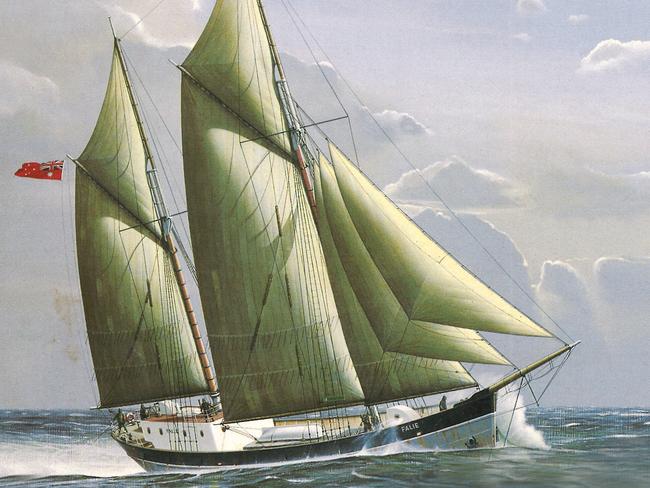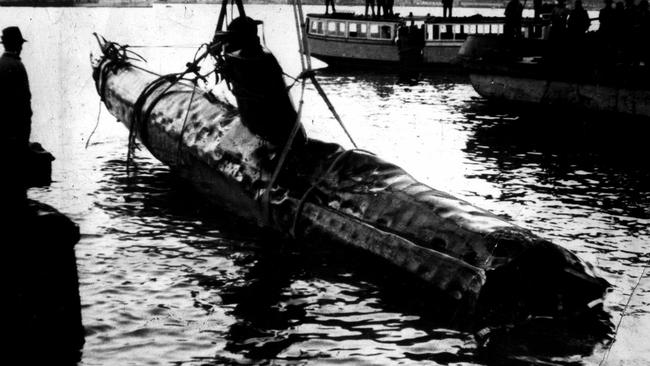She served South Australia with honour — but what now for Falie?
Tall ship Falie embodies the story of SA as an immigrant who did her best in boom and bust, once even besting a Japanese submarine during World War II — but the future of the famous ketch is uncertain.

SA News
Don't miss out on the headlines from SA News. Followed categories will be added to My News.
War hero, economic lifeline, rural community stalwart. If Falie was a woman we’d put her on a banknote.
Instead she is languishing at Port Adelaide, a once-proud working ketch now tied to a dock as a floating, static display, the last of her kind afloat.
Falie fans worried about her future are using the 100th anniversary of her birth to kickstart a campaign to get her sailing again.
It will take work — and money — but supporters say it will be an investment rather than a cost.

Chairman of the Falie Project which saw the ship restored for re-enactment voyages to mark South Australia’s 150th anniversary in 1986, Dr Andrew Cannon, said the ship is an integral part of the state’s maritime history.
“It would be a big job to get it back into survey (approved to sail) but we would like to see Falie as a not-for-profit centrepiece of a maritime heritage precinct,” he said.
Fellow supporter Trevor Gill said restoration could see Falie return to sheltered waters survey status, meaning she could take paying passengers on short voyages in the Port River Estuary out to the Fairway Beacon.
This would make her a working drawcard in a new tourism area in the Port, paying her own way.
Falie’s story is the story of South Australia in boom and bust, war and peace.
An immigrant, she was born in Holland as the Hollands Trouw, or Loyalty to the Netherlands.
Wartime coal shortages had revived the sail trade in the Netherlands’ fishing fleet but peace rapidly changed demand and Falie was designed as an elongated version of her earlier sisters complete with diesel engine.

Built at Maassluis by W. Richter Uitdenbogaardt she was originally a 33m steel schooner but was later converted to a ketch sails configuration.
Post-war South Australian farmers needed ships to transport grain to market in an era long before containerisation or mass road transport.
In 1922, the Spencer’s Gulf Transport Company Limited formed by Adelaide businessmen as well as rural investors sent Norwegian-born Captain Andreas Broun of Peterhead to Europe to acquire a suitable vessel to reach shallow, isolated ports and landings, particularly in Spencer Gulf and Gulf St Vincent.
He purchased the Hollands Trouw for 3600 pounds — later regarded as a bargain — and promptly re-named the ship Falie after his new wife Philomena.
After a quick trip to Norway to exchange a cargo of coke for timber and adventures including being stranded on a rock and icebound, Falie made the epic journey to Port Adelaide via South Africa to join the embryonic coastal ketch fleet.
Coastal communities across South Australia — many with either “Port” or “Bay” in their names — relied on coastal shipping, as did the farmers and inland rural communities of a young state.
In the 1920s there were some 75 isolated ports and landings from Fowlers Bay to Port Macdonnell, some in shallow water with no jetty, where the sea was the highway for nearby communities.
It was hard work — from manhandling hefty bags of grain off wagons to taking on the challenging seas and treacherous hazards of the run, the farmers, labourers and sailors who turned grain to gold earned their wages.
In some places bags of grain were slid down planks from cliffs to the ketches, in others bullock drays went out at low tide to unload.
Timber, superphosphate, wool, petrol, oil, gypsum, salt and supplies for settlements were also carried.

Falie’s master 1929-47 Captain Gustaf Bergland recalls: “Each week five or six men between them double-handled 9000 bags of wheat, each bag weighing 180 pounds, into and out of the Falie, then sailed the vessel on three delivery trips.”
In her long career under the Spencer’s Gulf Transport Company, Falie supplied food and other goods to regional communities while carrying mainly grain to Adelaide and to windjammers at anchor for national and world markets.
She was also a coastal trader working between Port Adelaide, Melbourne and northern Tasmanian ports, and later carrying bulk fuel and fertiliser between Adelaide and Kangaroo Island.
Her story changed abruptly in 1940 when the Royal Australian Navy commissioned Falie to support the war effort.
As HMAS Falie, later with guns added fore and aft, she initially served as an examination ship checking the bona fides of ships approaching Sydney Harbour before allowing them through a steel net boom gate.
On watchdog patrol on the night of May 31, 1942, Falie heavily struck a submerged object three times off Sydney Heads and reported the contact.
It was the night three Japanese midget submarines mounted an attack in Sydney Harbour, with the visiting American cruiser USS Chicago a prime target.
One sub fired two torpedoes and sank the former ferry HMAS Kuttabul, killing 19 Australian and two British sailors asleep on board and wounding another 10.
That sub disappeared until found by divers off Sydney’s northern beaches.
Another sub caught in the steel netting was blown up by the crew of two, while the final sub — possibly struck by HMAS Falie — was tracked.
The Australian War Memorial records it was destroyed by depth charges before firing any torpedoes.

Did our gallant Falie save ships and lives that night, even by accident, by being on vigilant patrol and damaging the sub?
The following day HMAS Falie relayed an urgent message from a fishing ship that the mother submarine had been sighted, resulting in Newcastle and Port Kembla being closed to outward shipping.
In 1943 HMAS Falie travelled extensively in dangerous waters from Port Moresby around the northern coast of what is now Papua New Guinea and Irian Jaya carrying stores and landing troops in enemy territory until the end of the war.
Adventures included towing small vessels in distress and rescuig the crew of the tug Tancred when it caught fire at sea.
After the war, Falie worked around Australia in the post-war mining boom, carefully delivering explosives as far afield as Cairns, Perth and Tasmania before returning to South Australia as a coastal trader.
However, the days of the coastal ketch were numbered and she worked until 1982 when she and sister ship Nelcebee ceased to trade.
Serendipitously the South Australian Jubilee 150 Board established by the State Government had a brief to plan and co-ordinate a wide range of South Australian sesquicentenary celebrations in 1986.
The Board decided a centre piece would be a re-enactment of the ketch grain trade, linking rural and city history, and it intended to charter Falie for the voyage.
Spencer’s Gulf Transport offered her to the Jubilee 150 Board at a cheap price and the Board restored the vessel as the flagship of the birthday celebrations.
With Federal and State Government support, major sponsorship from the Hindmarsh Building Society and the backing of the farming sector, metal trade employers and trade unions, Falie was restored.
A bonus was this provided work for many unemployed workers in the metal and associated trades during an economic slowdown, including more than 40 apprentices who were able to finish their trades as a result.
Falie was a huge success as a central feature of the Jubilee 150 celebrations.
Her primary role was in the grain trade re-enactment voyage, visiting ports around the State where tens of thousands of people, many in period costume, turned up to proudly witness Falie entering shallow waters to take aboard bagged grain, wool bales, salt, gypsum, copper and other goods from horse-drawn wagons as she and other ketches and schooners had done in the glory days of coastal trading under sail.
The re-born Falie linked communities around the state in a shared celebration of our agricultural, mining and maritime heritage.
She went on to work successfully as a school ship, sail training and tourism asset taking paying passengers on trips interstate and to many of the State’s ports, including youth development voyages for students.
She was taken out of survey by the State Government in 2005 and her future under government ownership is now uncertain.
The government provides some funding for maintenance and will do so until June 2020, but much of the work is carried out by volunteers.
Supporters say some of her steel hull plates are thin, the engine need work and the sullage and sewerage systems need an overhaul. A detailed analysis is needed before any cost estimate can be made but they are confident full restoration to sail in sheltered water is a viable goal.
In her long career Falie gamely survived incidents from collisions to strandings, was laid up in slow times and worked mercilessly in good, was a welcome sight in isolated communities and did her duty when Australia was under attack.
The question now is, do we let a grand old dame of the historic coastal trading run turning 100 this year just fade away?
People wanting more information on Falie can go to the Historic Ketch Falie Facebook page or e-mail historicketchfalie@hotmail.com



